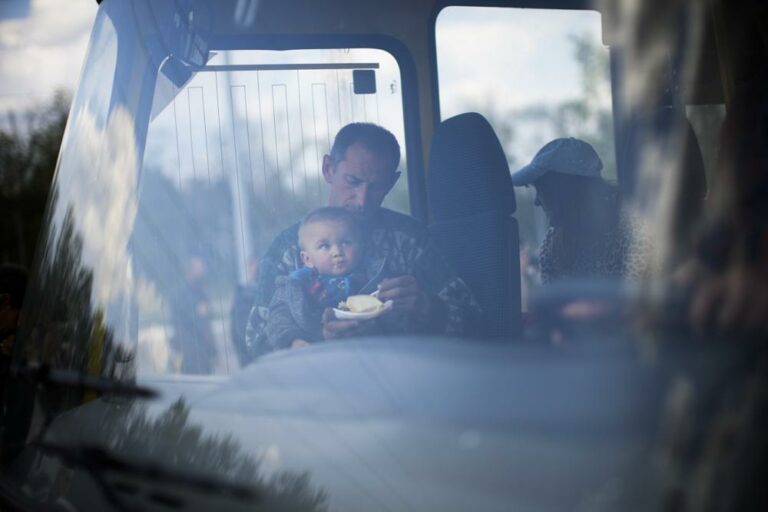People fleeing besieged Mariupol described weeks of bombardment and deprivation as they arrived Monday in Ukrainian-held territory, where officials and relief workers anxiously awaited the first group of civilians evacuated from the steel plant that is the last stronghold of Ukrainian fighters in the devastated port city.
Video posted online Sunday by Ukrainian forces showed elderly women and mothers with small children climbing over a steep pile of rubble from the sprawling Azovstal steel mill and boarding a bus.
More than 100 civilians from the bombed-out plant were expected to arrive in Zaporizhzhia, about 140 miles (230 kilometers) northwest of Mariupol, on Monday, Ukrainian President Volodymyr Zelenskyy said.
“Today, for the first time in all the days of the war, this vitally needed green corridor has started working,” he said Sunday in a video message.
However, at least some of the people evacuated from the plant on Sunday were apparently taken to a village controlled by Moscow-backed separatists. The Russian military said that some chose to stay in separatist areas, while dozens left for Ukrainian-held territory. The information could not be independently verified.
In the past, Ukraine has accused Moscow’s troops of taking civilians against their will to Russia. Moscow has said the people wanted to go to Russia.
The steel-plant evacuation, if successful, would represent rare progress in easing the human cost of the almost 10-week war, which has caused particular suffering in Mariupol. Previous attempts to open safe corridors out of the Sea of Azov city and other places have broken down, with Ukrainian officials repeatedly accusing Russian forces of shooting and shelling along agreed-upon evacuation routes.
Before the weekend evacuation overseen by the United Nations and the Red Cross, about 1,000 civilians were believed to be in the steel plant, along with an estimated 2,000 Ukrainian fighters. As many as 100,000 people overall may still be in Mariupol, which had a pre-war population of more than 400,000.
In other developments, European Union energy ministers met Monday to discuss new sanctions against the Kremlin, which could include restrictions on Russian oil — though Russia-dependent members of the 27-nation bloc, including Hungary and Slovakia, are wary of taking tough action.
Zelenskyy said he hoped more people would be able to leave Mariupol in an organized evacuation on Monday. The city council told residents wanting to leave to gather at a shopping mall to wait for buses.
As in the past when official evacuations faltered, some people managed to escape from Mariupol on their own, while others remained trapped.
“People without cars cannot leave. They’re desperate,” said Olena Gibert, who was among those arriving an a U.N.-backed reception center in Zaporizhzhia in dusty and often damaged private cars. “You need to go get them. People have nothing.”
She said many people still in Mariupol wish to escape the Russia-controlled city but can’t say so openly amid the atmosphere of constant pro-Moscow propaganda.
Anastasiia Dembytska, who took advantage of the brief cease-fire around the evacuation of civilians from the steel plant to leave with her daughter, nephew and dog, said her family survived by cooking on a makeshift stove and drinking well water.
She said could see the plant from her window, when she dared to look out.
“We could see the rockets flying” and clouds of smoke over the plant, she said.
Russian forces have pounded much of the city to rubble, trapping civilians with little food, water, heat or medicine.
Zelenskyy told Greek state television that remaining civilians in the steel mill were afraid to board buses because they believe they will be taken to Russia. He said he had been assured by the U.N. that they would be allowed to go to areas his government controls.
Thwarted in his bid to seize Kyiv, the capital, President Vladimir Putin has shifted his focus to the Donbas, Ukraine’s eastern industrial heartland, where Moscow-backed separatists have been battling Ukrainian forces since 2014.
Russia said its military struck dozens of military targets in the region in the past day alone. It said it hit concentrations of troops and weapons and an ammunition depot near Chervone in the Zaporizhzhia region, which lies west of the Donbas.
Ukrainian and Western officials say Moscow’s troops are raining fire indiscriminately, taking a heavy toll on civilians while making only slow progress.
The Ukrainian president’s office said at least three people were killed and seven, including a child, were wounded in the Donbas in the last 24 hours. The regional administration in Zaporizhzhia said at least two people died and four wounded in Russian shelling.
Ukraine’s military claimed Monday to have destroyed two small Russian patrol boats in the Black Sea. Drone footage posted online showed what the Ukrainians described as two Russian Raptor boats exploding after being struck by missiles. The AP could not immediately independently confirm the strikes.
Mariupol, which lies in the Donbas, is key to Russia’s campaign in the east. Its capture would deprive Ukraine of a vital port, allow Moscow to establish a land corridor to the Crimean Peninsula, which it seized from Ukraine in 2014, and free up troops for fighting elsewhere in the region.
In the wake of the evacuation from the city’s steel plant, Russian forces resumed shelling there Sunday, according to one of the Ukrainian defenders.
Denys Shlega, commander of the 12th Operational Brigade of Ukraine’s National Guard, said in a televised interview that several hundred civilians remained trapped alongside nearly 500 wounded soldiers and “numerous” bodies.
“Several dozen small children are still in the bunkers underneath the plant,” Shlega said.
A full picture of battle unfolding in eastern Ukraine is hard to capture. The fighting makes it dangerous for reporters to move around, and both sides have introduced tight restrictions on reporting from the combat zone.
But Britain’s Defense Ministry said it believes more than a quarter of all the fighting units Russia has deployed in Ukraine are now “combat ineffective” — unable to fight because of loss of troops or equipment.
Ukraine said Russia also struck a strategic road and rail bridge west of the Black Sea port of Odesa. The bridge already was heavily damaged in previous Russian strikes, and its destruction would cut a supply route for weapons and other cargo from neighboring Romania.
The attacks on the bridge followed a claim by a senior Russian military officer that Moscow aims to take control of the entire south of Ukraine and build a land corridor to Transnistria, a pro-Russian separatist region of Moldova where about 1,500 Russian troops are based.
Ukrainian and Western officials have voiced concern that Russia could use the region to open a new front in the war.
(AP)











